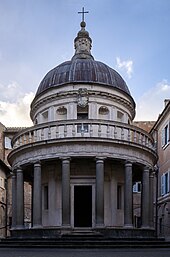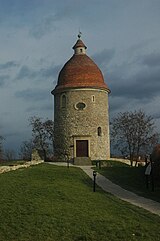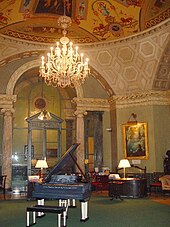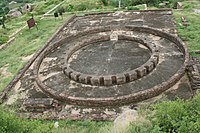|
Rotunda (architecture)
 A rotunda (from Latin rotundus) is any roofed building with a circular ground plan, and sometimes covered by a dome. It may also refer to a round room within a building (a famous example being the one below the dome of the United States Capitol in Washington, D.C.). The Pantheon in Rome is perhaps the most famous, and is the most influential rotunda. A band rotunda is a circular bandstand, usually with a dome. Classical architecture The terminology of Ancient Greek architecture and Roman architecture distinguishes between two types of rotunda: a tholos is enclosed by a wall, while a monopteros is just a circular colonnade with a roof (like a modern bandstand or park pavilion). It is not clear that any Greek example was actually a Greek temple,[1] but several were Roman temples, though mostly much smaller than the Pantheon, and with very different designs. The Temple of Hercules Victor and Temple of Vesta in Rome, along with the Temple of Vesta, Tivoli, are the best known and best preserved examples. The few large Greek tholoi had varied functions, not all of which are now clear. Several are at major religious sanctuaries, but seem not to have been conventional temples. At most only the foundations and a few columns remain in place. They include the Tholos of Delphi, the Philippeion at Olympia, a small memorial to the family of Philip of Macedon, and a large building at the Sanctuary of Asclepius, Epidaurus. The largest Greek tholos, of uncertain function, was built in the Samothrace temple complex in the 260s BC. It is often called the Arsinoeum, as a dedication tablet for the Ptolomeic Queen Arsinoe II of Egypt has survived. The sanctuary was a great Hellenistic centre of Greco-Roman mysteries and the building probably played some role in these.[2] The oldest, the Tholos of Athens, was a large and plain rotunda used as a dining hall, and perhaps more, by the city's ruling council.[3] Later, very large, Roman rotundas include the Castel Sant'Angelo in Rome, built in the 130s as a mausoleum for the emperor Hadrian, and in the Middle Ages turned into a castle, and the 4th-century Rotunda in Thessaloniki, probably also intended as an imperial mausoleum, but later used as a church and a mosque. The church of Santa Costanza in Rome is a circular funerary chapel of the 4th century, probably built for one or more of the daughters of Constantine the Great, originally placed next to a funerary hall that is now only a ruined wall. IndiaRemains of the circular temple at Bairat. A stupa was located in the center, with a colonnade and a circular wall around. 3rd century BCE. Ashoka's circular Mahabodhi Temple, Bharhut Some of the earliest free-standing temples in India are thought to have been of a circular type, as the Buddhist Bairat Temple in Bairat, Rajasthan, formed of a central stupa surrounded by a circular colonnade and an enclosing wall, built during the time of Emperor Ashoka and near which were found several Minor Rock Edicts.[4] Ashoka also built the Mahabodhi Temple in Bodh Gaya circa 250 BC, possibly also a circular structure, next to the Bodhi tree. Representations of this early temple structure are found on a 100 BCE relief from the stupa railing at Bhārhut, as well as in Sanchi.[5] These circular-type temples were also found in later rock-hewn caves such as Tulja Caves or Guntupalli. Circularity in Buddhist architecture was generally to allow a path for pradakshina or devotional circling of a round and solid stupa.[4] It has been suggested that these circular structures with colonnades may have originated with the Greek circular tholos temple, as in the Tholos of Delphi, but circular wooden huts in India are a more likely source of inspiration.[6]
Medieval and Renaissance Europe The Pisa Baptistery is the outstanding late medieval rotunda, taking from 1152 to 1363 to build, and including Romanesque, Gothic and classicizing or Proto-Renaissance elements. There are a number of other round churches. The rotunda with columns was revived in one of the most influential buildings in Renaissance architecture, the Tempietto in a courtyard of the church of San Pietro in Montorio in Rome. This was designed by Donato Bramante around 1502 in strongly classicizing style. It is a small building whose innovation, as far as Western Europe was concerned, was to use the tholos form as the base for a dome above; this may have reflected a Byzantine structure in Jerusalem over the tomb of Christ. The Roman Temple of Vesta (which has no dome) was probably also an influence. This pairing of tholos, now called a drum or tholobate, and dome became extremely popular raised high above main structures which were often based on the Roman temple.[7] Rotunda in Central EuropeA great number of parochial churches were built in this form in the 9th to 11th centuries CE in Central Europe. These round churches can be found in great number in Hungary, Poland, Slovakia, Croatia (particularly Dalmatia), Austria, Bavaria, Germany, and the Czech Republic. It was thought of as a structure descending from the Roman Pantheon. However, it can be found mainly not on former Roman territories, but in Central Europe. Generally its size was 6–9 meters inner diameter and the apse was directed toward the east. Sometimes three or four apses were attached to the central circle and this type has relatives even in the Caucasus.
Rotunda in the Carpathian Basin Several types of rotundas are found in the Carpathian Basin, within the former boundaries of Kingdom of Hungary. Building of rotundas in Carpathian basin started already in 9th century in Great Moravia. According to the research and radiocarbon dating of plaster, Rotunda of st. George in Nitrianska Blatnica was built sometimes around the year 830, what makes it one of the oldest still standing buildings in the area of Central Europe.[8][9] Similar rotunda was standing in hillfort Kostolec in Ducové (only foundations remained). The role and form of rotundas developed from gradual enlargements of ancient small village churches. Many of them still stand today, e.g. in Nagytótlak, Kallósd and Kissikátor in Hungary or in Bíňa and Šivetice in Slovakia. Rotunda in Šivetice is the biggest one in Central Europe, with diameter of 11 m.[10] In many places the ancient foundations have been excavated and conserved. The village church of Sárospatak is complete with a simple circular nave and an eastern apse. The church of Alagimajor at Dunakeszi was enlarged toward the apse in the 14th century. More significant enlargement of the central rotunda is seen at Isaszeg where the extension extended toward the East and West; the rotunda foundations can also be seen in the central portion of the nave of the Gothic church. In many cases the rotunda was used as the apse of the village's new and larger church (Bagod-Szentpál, Hidegség, Vágkeresztur, Ipolykiskeszi, Herencsény, Szalonna). Such semi-circle apses are preserved all over the Carpathian Basin. Rotundas of six apses, a most interesting form, are found at Karcsa, Kiszombor in Hungary, at Horjany in Ukraine and several places in Armenia (Aragatz, Bagaran, Bagnayr, Botshor, Kiagmis Alti).
The CaucasusThere is an interesting connection between Central European and Caucasian rotundas of the 9th to 11th centuries AD. Several Armenian built rotunda churches have sixfold arched central apsis, i.e. at Aragatz, Bagaran, Bagnayr, Botshor, Kiagmis Alti in Armenia. At the same time eightfold arched central buildings (rotunda) are also frequently occurring in Armenia: Ani, Irind, Varzhahan. It was a suggestion (Csemegi J.) that there was not only western European but Eastern Caucasian relation for architects of Hungary in this age of King Stephen I of Hungary. Good example of Georgian rotunda church is Bana cathedral which is now located on territory of Turkey. East Asia
Notable rotundas    Religious buildings
Buildings for entertainment
Residential buildings
Buildings for learning
Government buildings
Commercial buildings
See also
References
Further reading
External linksWikimedia Commons has media related to Rotundas. |





















